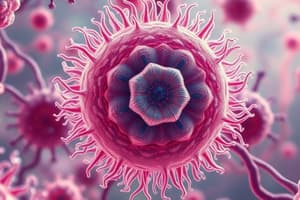Podcast
Questions and Answers
What are the distinguishing features between prokaryotic and eukaryotic cells?
What are the distinguishing features between prokaryotic and eukaryotic cells?
Prokaryotic cells lack a membrane-bound nucleus and other organelles, while eukaryotic cells have a membrane-bound nucleus and various organelles.
The largest cell in the human body is the ___
The largest cell in the human body is the ___
ovum
What is the world's largest cell by volume?
What is the world's largest cell by volume?
Ostrich egg cell
What is the world's longest cell?
What is the world's longest cell?
Which of these organisms are considered unicellular?
Which of these organisms are considered unicellular?
Prokaryotic cells reproduce via budding and binary fission.
Prokaryotic cells reproduce via budding and binary fission.
What is the main function of flagella in prokaryotic cells?
What is the main function of flagella in prokaryotic cells?
What is a plasmid?
What is a plasmid?
What is the primary composition of the prokaryotic cell wall?
What is the primary composition of the prokaryotic cell wall?
What is the role of ribosomes in prokaryotic and eukaryotic cells?
What is the role of ribosomes in prokaryotic and eukaryotic cells?
Eukaryotic cells are typically haploid.
Eukaryotic cells are typically haploid.
How are somatic cells created in a human body?
How are somatic cells created in a human body?
Flashcards are hidden until you start studying
Study Notes
Prokaryotic Cells vs. Eukaryotic Cells
- Prokaryotic cells are single-celled organisms also known as prokaryotes, primarily bacteria.
- Eukaryotic cells are multicellular and include organisms like plants and animals.
Characteristics of Prokaryotic Cells
- Lack membrane-bound organelles, including a defined nucleus.
- Typically haploid with a single circular chromosome located in the nucleoid.
- Reproduction occurs through binary fission or budding.
- Organelles like ribosomes are found; ribosomes synthesize proteins essential for cellular function.
Prokaryotic Cell Structure
- Flagella: Used for movement.
- Cytoplasm: Jelly-like substance that suspends organelles, contains cytosol.
- Plasmid: Circular DNA molecule involved in genetic information transfer; serves as a vector to introduce foreign DNA.
- Cell Wall: Composed of peptidoglycan; maintains shape and protects against damage.
- Cell/Plasma Membrane: Regulates entry and exit of substances; provides boundary from the environment.
- Capsule: Surrounds the cell wall; aids in adherence and prevents dehydration.
- Pili: Hair-like appendages that assist in sticking to surfaces.
Living Organisms
- Unicellular Organisms: Include bacteria, certain protists, and some fungi; can perform all life functions within a single cell.
- Multicellular Organisms: Include animals and plants that consist of multiple cells to perform complex functions.
Characteristics of Eukaryotic Cells
- Eukaryotic cells possess membrane-bound organelles, including a nucleus, mitochondria, and Golgi apparatus.
- Typically diploid, having two sets of chromosomes inherited from each parent.
- Reproduction occurs through gamete fusion; somatic cells are examples of diploid cells.
- Organisms may include algae and plants, which contain chloroplasts for photosynthesis.
Key Differences
- Prokaryotes are generally microscopic and primarily single-celled, while eukaryotes can be macroscopic and often multicellular.
- Prokaryotes have nonmembrane-bound structures; eukaryotes feature complex organelle systems with membranes.
- Prokaryotic cells often reproduce asexually, while eukaryotic cells typically undergo sexual reproduction.
Gametes and Cell Division
- Gametes (egg and sperm cells) in humans are haploid and produced in testes and ovaries.
- Somatic cells, which are diploid, originate through mitotic division, resulting in growth and tissue repair.
Studying That Suits You
Use AI to generate personalized quizzes and flashcards to suit your learning preferences.




